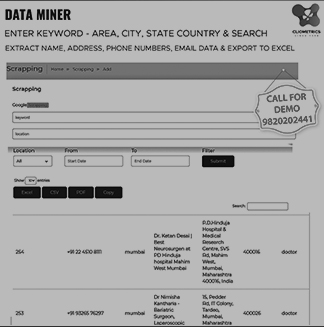A facial recognition biometric system identifies and verifies a person by extracting and comparing selected facial features from a digital image or a video frame to a face database. For example, an algorithm may analyze the distance between the eyes, the width of the nose, the depth of the eye sockets, the shape of the cheekbones, the length of the jaw line, etc., and encode the corresponding data as face prints, which can then be used to find appropriate matches in a destination database.
Speaker or voice recognition differs from speech recognition in that the former recognizes and identifies a speaker using voice biometrics and the latter analyzes what is being said. Voice biometrics include both physical characteristics, such as the shape of the vocal tract responsible for articulating and controlling speech production, and behavioral characteristics such as pitch, cadence and tone, etc.
Most fingerprint biometric solutions look for specific features of a fingerprint, such as the ridge line patterns on the finger, the valleys between the ridges, etc., commonly known as minutiae, which are then converted to stored digital data. In order to get a fingerprint match for verification or authorization, biometric systems must find a sufficient number of minutiae patterns. This number varies across systems.

Different biometric recognition methods offer different set of features, advantages and disadvantages. Cost is also an important factor to consider while choosing a biometric recognition system. For high security applications, multi-factor authentication or multi-modal biometric implementation can be considered, while low security applications can be implemented with single biometric modality.
Multi-modal biometric applications may hike up the investment required multi-fold, so there has to be a balance of everything and a thorough return on investment study may be required before taking up multi-modal biometric recognition.
Fingerprinting is the most popular modality among all biometric recognition methods. Being inexpensive, easy to implement and use, it has most penetration in authentication and access control applications as well as consumer electronics like mobile phones and portable devices.
Both, businesses and governments have recognized potential of biometric recognition systems and are leveraging them for various identification and authentication purposes. With successful adoption at various fronts like access control, civil identification, border control, law enforcement, etc. it can be said that biometrics is rapidly growing and has good prospects for the future. Global adoption and successful implementation across industries have showed that biometrics is the way forward. Market intelligence companies also predict exponential growth of biometric recognition in the future.
We operate in an Industry built on TRUST. SmartCards India is here to provide you with more information, answer any questions you may have and create an effective solution for your needs.
Connect



Cliometrics loves to interact with business mined people, startups and small and medium enterprises. Connect with the top-rated web and mobile app development company that offers cross-platform web and mobile application development in the mobility space and technology solutions.
Contact us to get along with us! It becomes a lot more amazing when we get together.